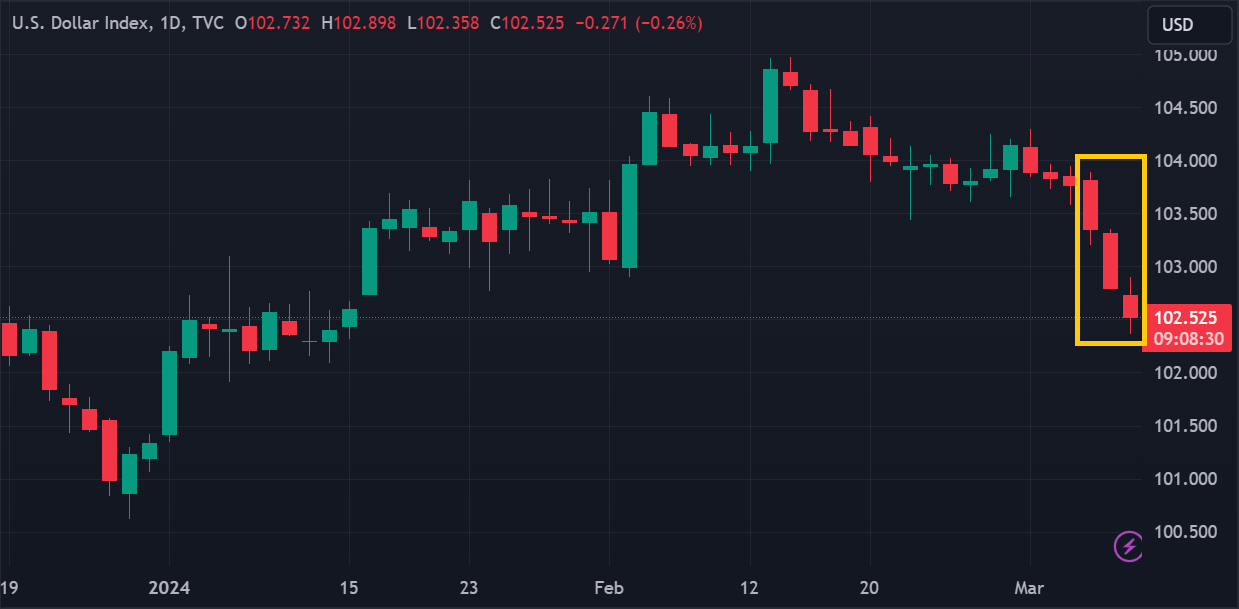Nonfarm payrolls outperformed expectations in February 2024. However, the US wage growth and unemployment rate data were very disappointing.
Wall Street stock markets set new record highs in trading on Friday (8/March) thanks to a mixed US labor report. However, the same report resulted in the US Dollar Index (DXY) falling to its lowest level since mid-January at 102.35. The greenback was battered in all major pairs.

Nonfarm payrolls rose by 275k in February 2024, much higher than the consensus estimate of 198k. However, other details were very disappointing.
US Bureau of Labor Statistics (BLS) revised the Nonfarm Payroll data for January 2024 from 353k to 229k. Average Hourly Earnings growth was recorded to weaken to 4.3% (y/y) in February 2024, while its January data was revised down from 4.5% (y/y) to 4.4% (y/y). Even worse, the US Unemployment Rate skyrocketed from 3.7% to 3.9% in February.
Market participants took these data as indirect confirmation for the Fed's rate cut expectation starting in June. This also aligns with the Fed boss' testimony regarding the prospect of monetary easing in the first half 2024.
"What can be concluded in the short term is the focus on the unemployment rate which increased from 3.7% to 3.9%," said Robert Pavlik, Senior Portfolio Manager at Dakota Wealth, as quoted from Reuters, "The rising unemployment rate implies that the economy is slowing down, so in the market's view it is expected to require a faster rate cut."
USD/JPY fell nearly 1% following this report. On the other hand, GBP/USD bounced around 0.6% to its highest level since July 2023.
EUR/USD touched its highest level since mid-January at 1.0980s but soon receded to the 1.0960 range at the time of writing. Yesterday, The ECB boss signaled for a European interest rate cut starting in June.
Market attention will turn to the release of US Inflation data next week. If the data weakens further, the market will likely be bolder in placing short positions on the USD.

 Dedicated FREE FOREX VPS
Dedicated FREE FOREX VPS Free FOREX Virtual Private Server
Free FOREX Virtual Private Server MT4 Demo Contest, Get $500
MT4 Demo Contest, Get $500 Sign Up for an Account, Claim 60% Deposit Bonus
Sign Up for an Account, Claim 60% Deposit Bonus Free MT4/MT5 VPS 2024
Free MT4/MT5 VPS 2024 Send E-mail and Get Free Merchandise
Send E-mail and Get Free Merchandise $1K Refer a Friend Bonus for Pepperstone Pro clients
$1K Refer a Friend Bonus for Pepperstone Pro clients Maximize Your Earnings with 100% Deposit bonus
Maximize Your Earnings with 100% Deposit bonus Trade to Win, $5,000 Monthly Demo Contest
Trade to Win, $5,000 Monthly Demo Contest Claim 30% + 15% Deposit Bonus from LiteFinance
Claim 30% + 15% Deposit Bonus from LiteFinance






